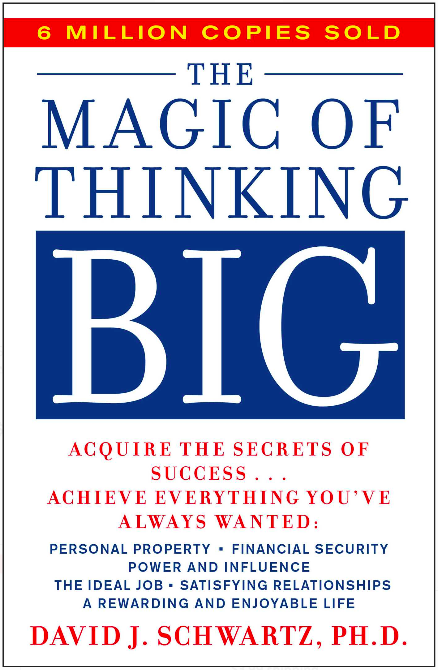 The Magic of Thinking Big. originally published in 1959
The Magic of Thinking Big. originally published in 1959
When I finally sat down to read this classic, I was unimpressed.
I?m pretty much a personal development connoisseur at this point, and I expected more out of this top-rated, had-to-wait-on-the-library-waiting-list-for-this-50+year-old book.
And?the advice in the beginning pages is just what you expect.
Believe you can succeed and you will.
Thanks, David. Putting me to sleep ? thanks for the positive thinking reminder, but back to binge-watching Shark Tank I go(and I?ll probably learn more from that show than from your tired advice).
But I promised myself I?d finish this book?
So, the next section? Not much better.
Cure yourself of excusitis. Yup, got it.
Next?
Build confidence and destroy fear. Thanks to Tim Ferriss?s fear setting, I?m good.
Then,
Think Big. Ok, maybe we?re getting to the meat and potatoes finally.
But, nope. Not yet.
After the preamble, designed I suppose to pump you up, Schwartz finally gets to the more interesting parts of his 302-page book.
Below, you?ll find some of the key lessons (of MANY packed into that monster):
[Sidenote: Get my next book reviews in your inbox.]
1. Be Human
The other day, I was at a farm picking up some apples and a pumpkin. When I went up to pay, I realized no one was behind me. I had no need to hurry; the farmer, who was acting as the cashier, was staring straight into my eyes and smiling. I woke up, bantered with him, and shared a laugh, instead of shoving money and hustling away (I blame New York for encouraging my tendency to slip past people interactions as quickly as possible).
It was a bit of sunshine in my day.
Now, I just have to bring that to everything I do.
Schwartz advises you to treat people as well as you can, whether you?re in a leadership position or all the way at the bottom of the totem pole.
Give everyone the benefit of the doubt, have patience, and remember that most people are good deep down. Give people the beauty of grace.
I always try to remember the Pygmalion Effect: People will rise to your expectations (so set them high!).
Another tip is conversation generosity.
As Schwartz puts it:
?There is no surer way to get people to like you than to encourage them to talk to you.?
You should aim to let your chit-chat partner say more than you do. This works absolute wonders in interviews, coffee dates, romantic dating, and with family. People like you more the more they get to talk about themselves. So, ask questions, be curious, and as Schwartz says, be human.
2. Thinking It?s Possible Makes It So
Believing Allows You to See the Routes to Success
?Believe it can be done. When you believe something can be done, your mind will find the ways to do it. Believing a solution pays the way to solution.?
Schwartz uses a class example to illustrate this point. He had his students think of all the ways to end the prison system within a certain number of years. Within minutes, the class turned from nitpicking all the downsides to closing prisons, to thinking up creative, innovative solutions. The hardest part of the exercise, Schwartz writes, was calming his students down to end the thought experiment as people fed off each other?s creative energy of solving a hard problem.
Assuming a seemingly impossible objective is possible is used by many contemporary personal development authors. For example, Tim Ferriss uses it when he describes comfort challenges, where he asks his readers to try to make X amount of money in a certain time frame.
When you change from thinking, this might be possible, to how do I accomplish it? your mind immediately goes to work to find a way to accomplish your mission.
An example in my life was my goal of teaching yoga while still in the military. Once I changed from just wishing I was a yoga teacher, to realizing I wanted to teach before the end of the year, I found multiple routes to success.
I woke up at 4am and taught mobility yoga at a Crossfit gym before I had to head to post. I taught fellow service members one day a week at the on-post athletic facility, and on weekends I substituted for several local studios. I made it happen once I turned the thought into, I?m finding a way to make it happen.
3. Ignore the Haters
Super simple advice, but always smart to remind yourself: If someone is a downer, gossiper, naysayer, or just plain mean, ignore them.
Change the subject, walk away, or simply nod and say, ?Oh, I see.? For people you can?t run away from at work, Ask a Manager has some good advice.
When it?s your family, remember, even the most advanced of us struggle with that. As Ram Dass said:
?If you think you are enlightened, go and spend a week with your family.?
At the end of the day, if you can spend 80% of your time with positive (or even neutral), supportive folks, you?re golden.
4. One Step At a Time
This story stuck with me.
Schwartz illustrates the point that every big endeavor requires a repetition of small, seemingly simple endeavors, with the following vignette.
From Chapter 12:
Eric Sevareid, an author and correspondent, reported in Reader?s Digest in 1957:
?During World War II, I and several others had to parachute from a crippled Army transport plane into the mountainous jungle on the Burma-India border. It was several weeks before an armed relief expedition could reach us, and then we began a painful, plodding, march ?out? to civilized Inida. We were faced by a 140-mile trek, over mountains, in August heat and monsoon rains.
In the first hour of the march I rammed a boot nail deep into one foot; by evening I had bleeding blisters the size of a 50-cent piece on both feet. Could I hobble 140 miles? Could the others, some in worse shape than I, complete such a distance? We were convinced we could not. But we could hobble to that ridge, we could make the next friendly village for the night. And that, of course, was all we had to do?
When I relinquished my job and income to undertake a book of a quarter of a million words, I could not bear to let my mind dwell on the whole scope of the project. I would surely have abandoned what has become my deepest source of professional pride. I tried to think only of the next paragraph, not the next page and certainly not the next chapter. Thus, for six solid months, I never did anything but set down one paragraph after another. The book ?wrote itself.??
Shwartz says, ?progress is made one step at a time. A house is built one brick at a time. Football games are won a play at a time?Every big accomplishment is a series of little accomplishments.?
To make your dreams come true, you must take action, but that action shouldn?t be grand.
For me, it?s sitting my butt down and writing as often as I can; or, it?s signing up for a course that will make me better, and actually completing it and participating fully.
For you, it might mean securing a domain name, setting up your first website, and launching a first product.
Or, perhaps it?s going to the grocery store, buying healthy food for the week, and making one healthy meal. And then another, and another.
Whatever your goal, you can take one forward step toward it, probably right now (look away from the internet and go, go, go!).
5. Do More, Not Less (But Take Time to Think)
This phrase, written in the book, (and posted on my Twitter a few months ago), is a longtime favorite maxim:
If you want something done, ask a busy person to do it
I see this play out everywhere: at work, it?s the person who already wears five hats who is asked to plan the holiday party, order business cards for everyone in the company, fix the landing page, and attend a last-minute conference as well as take care of day-to-day duties, while the person with one role, who works strictly 10?5pm, fails to accomplish the one thing on his plate.
In the military, it was the same thing. The person in the S-3 operations shop who worked the craziest hours, yet still found time to work out, see his family, and help mentor junior soldiers, was the go-to person to help you book your range, figure out a funding issue, and to arrange travel and school for me and my soldiers. Meanwhile, the senior sergeant who sat in the corner with a laptop and one duty, somehow failed to accomplish his one task on time or to standard.
With friends, I notice that I?m able to consistently coordinate time on our calendars to get dinner, drinks, or catch-up, with the people who have the most on their plate: multiple jobs, crazy work hours, blossoming side projects, a consistent exercise routine, and complex family situations.
Those who don?t work full-time, have any side jobs, any regular hobbies or practices, or any true deadlines, are the ones who cancel, fail to follow through, and who never seem to make progress on their personal goals.
Being busy forces you to find ruthless efficiency and prioritization.
In my personal life, I?ve found that my capacity to get shit done increases the second I add responsibilities, projects, classes, and hobbies to my plate.
Even Jennifer Lawrence agrees:
?When I?m not working, I am the laziest person. I can literally lie on a couch and watch television for 15 hours.?
Only you know your capacity, but I?d always advise adding more before taking away. At the very least you might stretch and find you?re able to do much more than you thought. Volume also brings the need to quit wasting time on stupid stuff. For me, it?s social media and endlessly reading random articles on the internet. When I have a full plate of work, freelancing, yoga teaching, volunteering, meal prepping, and social activities, I stop dawdling time away on unfulfilling time-sucks.
So Nice They Said It Twice: The Same Advice in The Magic of Thinking Big and How to Win Friends and Influence People by Dale Carnegie
From the moment I started Schwartz?s book, I recognized the pattern of writing (and it?s very effective) employed by the original self-help emperor, Dale Carnegie.
Real People as Case Studies
Schwartz weaves personal experience with case studies of his friends, students, and associates. He uses names, background information, and some key details to give you the sense you?re reading about real people making real changes in their lives, instead of defaulting to generalities.
People First, and Friends and Success Will Follow
Mission first, people always, a phrase burned into my memory from my past life in the military (it?s from the Cadet Creed), comes to mind for me with all the human-centric leadership advice in Schwartz?s book.
It?s the same as Carnegie?s.
If you center your life on being kind, considerate, and human to everyone you come in contact with, you?ll get ahead.
With your boss, subordinates, family, friends, and neighbors, not to mention people you come into casual contact with, like your local barista, impress on yourself that they matter. Make it a habit to remember names, birthdays, and smile, as you really give each person your full attention.
Carnegie and Schwartz say the same thing, in many of the same terms.
Follow the Golden Rule (Carnegie?s words) and Be Human (Schwartz?s).
Treat others how you?d like to be treated.
Everyone craves appreciation, respect, and recognition.
The short comparison:
Similarities Between The Magic of Thinking Big and How to Win Friends and Influence People
- Storytelling patterns
- People advice: Be human, remember names, listen more and speak less, be interested in your fellow man, serve others to get ahead and be
- Friendly, conversational writing
- Numbered, actionable takeaways at the end of each chapter
- Including veterans in many of the anecdotes
Looking for more personal development? Head on over to 5 Practices from Deep Work by Cal Newport That?ll Change Your Life,
Have a book you?d like me to review so you can get the essential takeaways? Send me a note! Connecting with a fellow personal development nerd will make my day.


